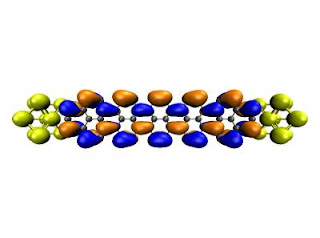Nayak, Shemella, and their team outlined their findings in the report “Energy Gaps in Zero-Dimensional Graphene Nanoribbons” published in the July 23 issue of Applied Physics Letters.
Nayak, Shemella and the group took 1-D nanoribbons and trimmed the length down to a few nanometers, so the length was only a few times greater than the width. The lengths of the resulting zero-dimensional graphene nanorectangles had clear and distinct effects on the material’s properties.
The team used quantum mechanical simulations with predictive capability to carry out this work. Their computational study showed for the first time that the length of graphene may be used to manipulate and tune the material’s energy gap. This is important because energy gaps determine if the graphene is metallic or semiconducting.
Generally, when graphene is synthesized, there is a mix of metallic and semiconductor materials. But Nayak’s findings give researchers a blueprint that should allow them to purposefully make entire batches of either one or the other.
This research is an important first step, Nayak and Shemella said, for developing a way to mass produce metallic graphene that could one day replace copper as the primary interconnect material on nearly all computer chips.
The size of computer chips has shrunk dramatically over the past decade, but has recently hit a bottleneck, Nayak said. As copper interconnects get smaller, the copper’s resistance increases and its ability to conduct electricity degrades. This means fewer electrons are able to pass through the copper successfully, and any lingering electrons are expressed as heat. This heat can have negative effects on both a computer chip’s speed and performance.
Researchers in both industry and academia are looking for alternative materials to replace copper as interconnects. Graphene could be a possible successor to copper, Nayak said, because of metallic graphene’s excellent conductivity. Even at room temperature, electrons pass effortlessly, near the speed of light and with little resistance, through metallic graphene. This would almost ensure a graphene interconnect would stay much cooler than a copper interconnect of the same size.
It will likely be years before a graphene interconnect is realized, but major computer companies including IBM and Intel have taken notice of the material. Nayak said graphene is also currently a “hot topic” in academia.
Carbon nanotubes, which are essentially made of rolled-up graphene, are another potential heir to replace copper as the primary material used for interconnects. But they suffer from setbacks similar to those of graphene, Nayak said. When single-walled carbon nanotubes are synthesized, about one-third of the batch is metallic and the remaining two-thirds are semiconductors. It would be extremely difficult to separate the two on a mass scale, Nayak said. On the contrary, recent research at Rensselaer and elsewhere shows graphene could be produced in a more controlled way.
“Fundamentally, at this point, graphene shows much potential for use in interconnects as well as transistors,” Nayak said.
It is also possible that semiconductor graphene could one day be used in place of silicon as the primary semiconductor used in all computer chips, but research into this possibility is still extremely preliminary, Nayak said. ###
Along with Nayak and Shemella, other authors of the paper include Pulickel M. Ajayan, the Henry Burlage Professor of Materials Science and Engineering at Rensselaer, as well as Rensselaer physics graduate students Yiming Zhang and Mitch Mailman.
The ongoing research project is funded by the Interconnect Focus Center New York at Rensselaer, the National Science Foundation, and the Office of Naval Research. The computations are carried out with support from the Scientific Computation Research Center and with the use of the IBM Blue Gene machine through a Shared University Research (SUR) grant to Rensselaer.
About Rensselaer: Rensselaer Polytechnic Institute, founded in 1824, is the nation’s oldest technological university. The university offers bachelor’s, master’s, and doctoral degrees in engineering, the sciences, information technology, architecture, management, and the humanities and social sciences. Institute programs serve undergraduates, graduate students, and working professionals around the world.
Rensselaer faculty are known for pre-eminence in research conducted in a wide range of fields, with particular emphasis in biotechnology, nanotechnology, information technology, and the media arts and technology. The Institute is well known for its success in the transfer of technology from the laboratory to the marketplace so that new discoveries and inventions benefit human life, protect the environment, and strengthen economic development.
Contact: Michael Mullaney mullam@rpi.edu 518-276-6161 Rensselaer Polytechnic Institute
Technorati Tags: Nano or Nanotechnology and Nanotech and Graphene nanoelectronics or Rensselaer Polytechnic Institute and Zero-Dimensional Graphene Nanoribbons or computer chip Tightly packed molecules lend unexpected strength to nanothin sheet of material and Volkswagen Karmann Ghia and Secretary Rice Signs Assistance Package for Palestinian Security VIDEO PODCAST

















No comments:
Post a Comment